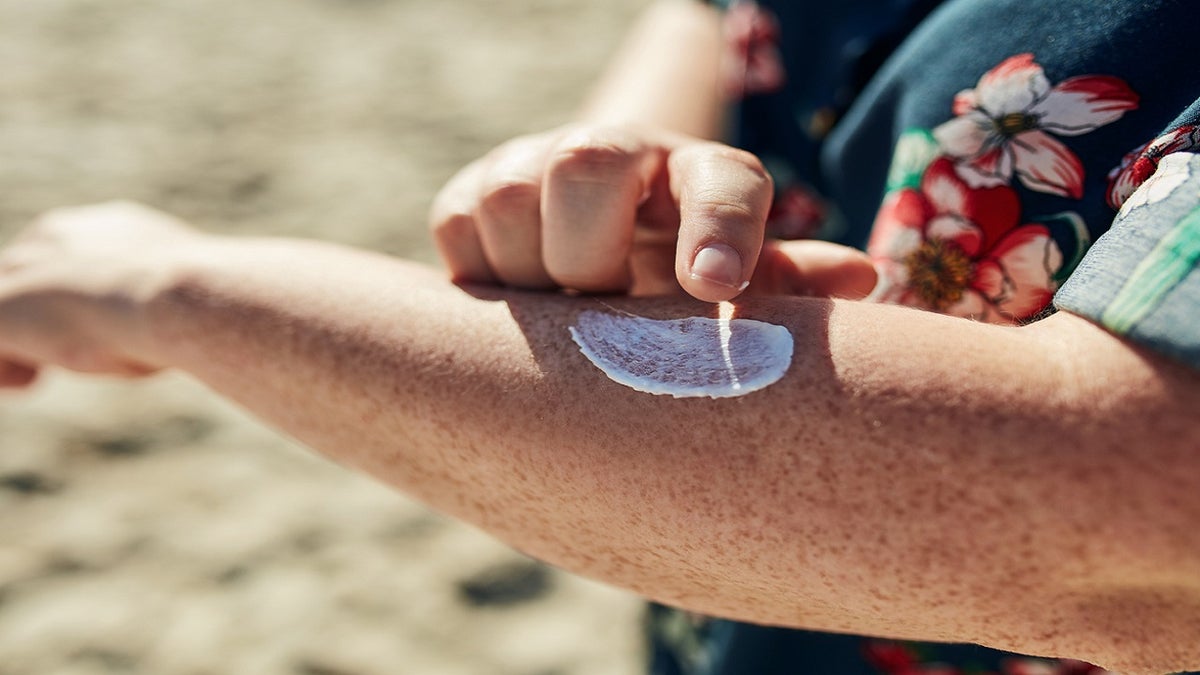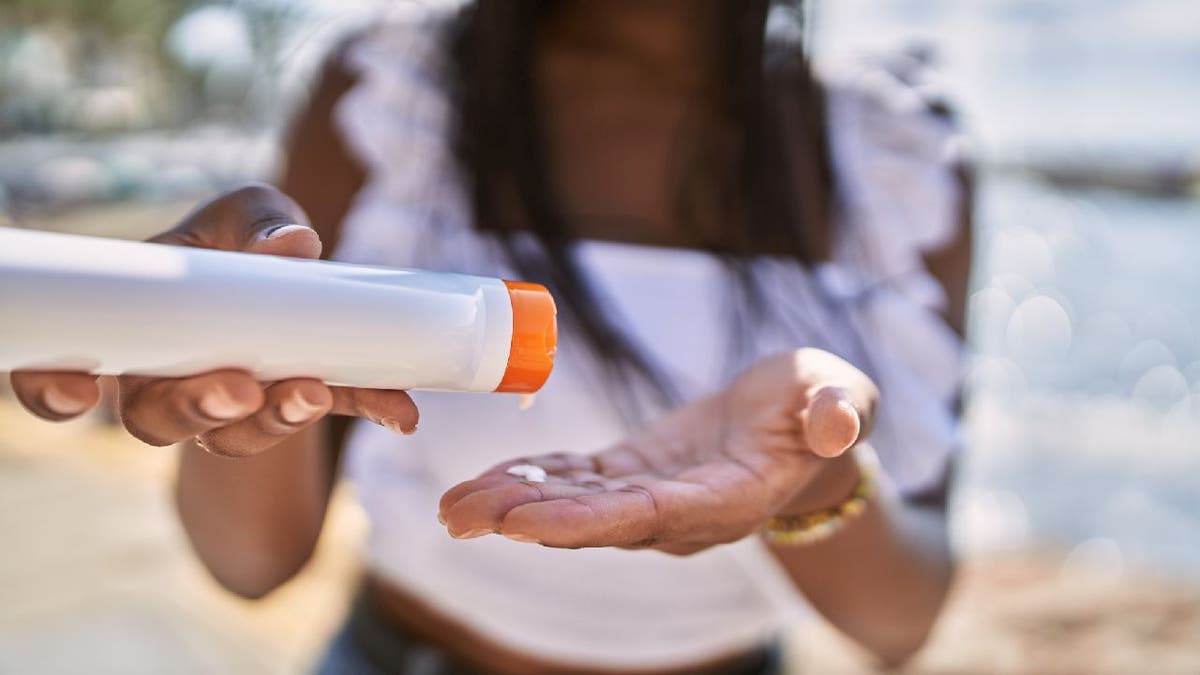Fox News Flash top headlines for July 2
Fox News Flash top headlines are here. Check out what's clicking on Foxnews.com.
While the U.S. Food and Drug Administration (FDA) has regulations that require commercial sunscreens to have stable formulations that last for at least three years, it can be tricky to know whether your SPF has reached its end.
Consumers who have purchased FDA-approved sunscreens can expect to find expiration date labels printed right on the product’s packaging.
For lotion tubes and bottles, the manufacturer’s production year and day are typically written in an alphanumeric code that can appear at the top or bottom of the container. The first two numbers represent the year the sunscreen was made while the next three numbers represent the calendar day.
HOW TO WEAR SUNSCREEN THE RIGHT WAY: YOUR GUIDE TO SPF
Expiration dates, on the other hand, are usually a bit clearer with an "EXP" marker followed by the month and year a sunscreen should go bad.

In this photo example of the Neutrogena Ultra Sheer with Helioplex Technology sunscreen, the product's lot number and expiration date are listed at the back of the lotion tube, near the top. The sunscreen expired in October 2021. This Neutrogena product isn't listed in Johnson & Johnson's 2021 national recall. (Cortney Moore/Fox News Digital)
Production date codes and expiration dates are also printed onto spray-on sunscreens and can usually be found at the base of the bottle.
Sunscreens from other countries, which have become trendier in recent years due to e-commerce, are usually regulated by agencies from their place of origin and will need to be reached by the consumers.
Consumers should take note of how they’re storing their sunscreen and the product’s consistency.
For example, the European Commission that represents the EU has its own list of testing, efficacy and labeling standards while individual countries throughout Asia, Africa, Australia and North and South America have regulations that may classify sunscreens as either a cosmetic or over-the-counter drug.
Aside from keeping an eye out for expiration labels, consumers should take note of how they’re storing their sunscreen and the product’s consistency, according to the FDA.
BE WELL: CATCH SKIN CANCER WARNING SIGNS EARLY WITH REGULAR SELF-EXAMS
"To keep your sunscreen in good condition, the FDA recommends that sunscreen containers should not be exposed to direct sun," an FDA spokesperson told Fox News Digital via email.
"Protect the sunscreen by wrapping the containers in towels or keeping them in the shade," the spokesperson added. "Sunscreen containers can also be kept in coolers while outside in the heat for long periods of time."

Leaving a sunscreen container in a hot setting can diminish the product's effectiveness, the FDA and Dr. Anna Guanche told Fox News Digital. (iStock)
Dr. Anna Guanche, founder and director of Bella Skin Institute in Calabasas, California, warns that hot indoor settings can impact a sunscreen’s effectiveness.
"Sunscreen most certainly does expire and when it does, it loses its strength and is less effective at blocking UV rays," Guanche wrote to Fox News Digital.
"If the sunscreen has been left in a hot car for a long period of time, for example, or separated it is best to invest in a new bottle of sunscreen just in case," she added.
Consumers should be able to find proper storage and use instructions listed on sunscreen labels, according to the FDA.
WHAT SPF SHOULD YOUR SUNSCREEN HAVE? FIND OUT HOW IT MAY HELP PREMATURE AGING AND SKIN CANCER
"There is no expiration difference between the face or body sunscreen. Expired is expired. Although expiration dates are guidelines, it is best not to take a chance of having ineffective sun protection," Guanche advised.
"Lotions versus spray is the same," she added. "You want to check the expiration date on the bottle because if it’s expired, it loses its effectiveness of protecting your skin."

If there are color or texture changes in your sunscreen before its expiration date, it is best to replace it with a fresh product. (iStock)
In addition to being mindful of expiration dates, you may want to look into whether a recall has been issued for sunscreen products that were purchased last summer or before.
In 2022, Banana Boat voluntarily recalled four batches of the Banana Boat Hair & Scalp Sunscreen Spray SPF 30, FOX Business reported at the time. The recall had been issued after the company discovered some samples of the product contained trace levels of benzene – an organic chemical compound that can cause cancer with high exposure, according to the Centers for Disease Control and Prevention.

Before reaching for the sunscreen bottle that's been sitting at the bottom of your beach bag or in your medicine cabinet since last summer, you may want to look into whether a recall has been issued for sunscreen products as well as expiration dates. (iStock)
In July 2021, Johnson & Johnson Consumer Inc. issued a voluntary recall affecting a handful of the sunscreen products in its aerosol product line.
The company had recalled select sunscreens from Neutrogena and Aveeno for potential benzene contamination.
Benzene was reportedly not an ingredient lists in Johnson & Johnson sunscreen products, FOX Business and Reuters reported at the time.
CLICK HERE TO SIGN UP FOR OUR LIFESTYLE NEWSLETTER
Benzene was found in four Neutrogena products: Beach Defense, Cool Dry Sport, Invisible Daily Defense and Ultra Sheer products. It was also found in one Aveeno product: Aveeno Protect + Refresh sunscreen.
Johnson & Johnson and Costco Wholesale Corp. had reached a tentative agreement over lawsuits in connection with the recalled sunscreens after benzene was detected in the products.





















